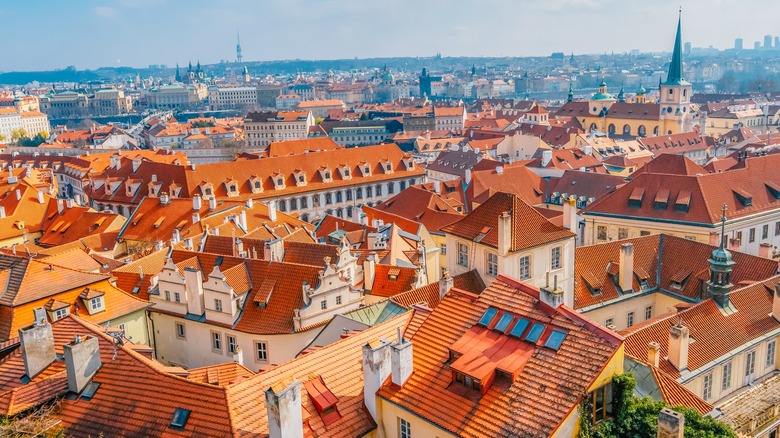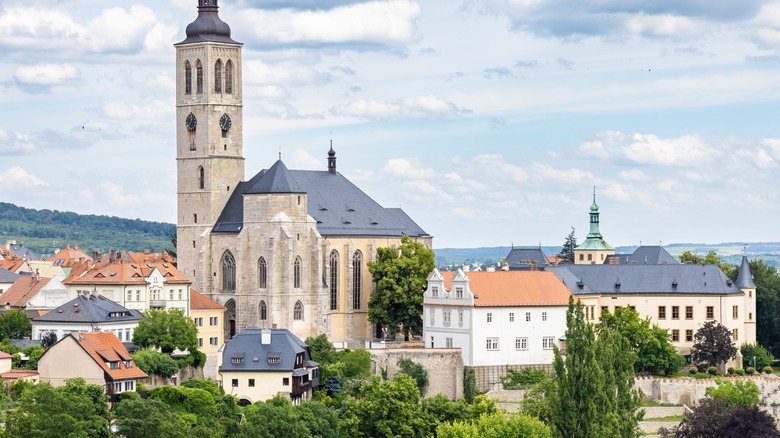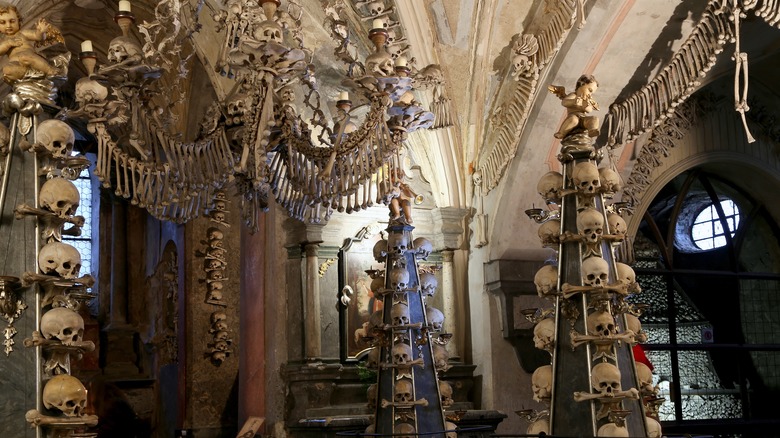One Of Rick Steves' Favorite Day Trips From Prague Is This Under-The-Radar Medieval Town
As the head for "Rick Steves Europe," Steves practically has the entire continent mapped out in his brain. Packed with a treasure trove of useful travel tips, he's the go-to guy for anyone looking to go to hidden gems and avoid all the tourist-infested places in Europe. Want to explore solo but avoid feeling like a lonely wanderer? He's got you covered, too. And when it comes to day trips, he's all about encouraging you to explore the off-beaten path — especially if you're in Prague. His top pick? The slightly spooky — but totally worthy of a detour — town of Kutná Hora.
Also dubbed as the "City of Silver," Kutná Hora isn't exactly a bustling metropolis, nor is it considered a "second city," aka those affordable types of European cities with fewer crowds that Steves says he normally prefers. "Kutná Hora, a beautifully preserved and down-to-earth town, is just a one-hour direct train ride from Prague. With a current population of just 20,000 it can hardly be categorized as a 'second city' to Prague, but it was considered the second city of Bohemia in the 17th century," Steves wrote on his site.
But while it's not jam-packed with activities, for history buffs and those looking to escape the chaos of Prague, it's a solid choice. The town's center has been a UNESCO World Heritage Site since 1995, thanks to its spots that have major cultural and historical contributions. Its most famous sites include the stunning Saint Barbara's Church, the Gothic Cathedral, and the chilling Ossuary of the Cemetery Church of All Saints, a chapel made almost entirely of human bones. Yes, you read that right — the chapel is adorned with the bones of over 40,000 people, and that fact alone is enough to squeeze it into your itinerary.
It's worth taking a detour to Kutná Hora for the Czech Museum of Silver and the Cathedral of St. Barbara
During the Kingdom of Bohemia, Kutná Hora wasn't just another sleepy town — it was the big shot right after Prague, thanks to its booming silver mines. These mines churned out the legendary Prague groschen coins, the cash of choice throughout medieval Europe until the 1600s. The mines may have closed in 1727, but the town's shiny history is alive and well at the Czech Museum of Silver, where you can learn all about how the mines worked and miners' gritty day-to-day life. "Kutná Hora sits on top of what was once the world's largest silver mine and, in its heyday, much of Europe's standard coinage was minted here," Rick Steves penned on his site. "At the town's Czech Museum of Silver, you can join a tour and spelunk in the former miners' passages that run beneath the town center."
Mining was so central to Kutná Hora's identity that they even built a cathedral to honor St. Barbara, the patron saint of miners. The Cathedral of St. Barbara, a Gothic masterpiece that took five centuries to complete, is one of the most stunning churches in Europe. It's decked out with Baroque paneling, stained glass, Gothic and Renaissance paintings, and — because this is Kutná Hora — frescoes celebrating the town's mining legacy. "In addition to financing much of Prague's grand architecture, the glittering silver deposits also paid for Kutná Hora's opulent Gothic cathedral, St. Barbara's, dedicated to the patron saint of mining," Steves went on to explain. "Its dazzling interior celebrates the town's sources of wealth, with frescoes featuring mining and minting." Kutná Hora sure is a town that knows how to flaunt its riches!
The Sedlec Ossuary or the Church of Bones is also a must-see
Just a quick 6-minute drive from the Cathedral of St. Barbara lies one of the eeriest yet fascinating sites in the Czech Republic if not all of Europe: the Sedlec Ossuary, better known as the "Church of Bones," for the very fact that most of it is made out of human skeletal remains. According to Rick Steves, most of the 40,000 bones used to construct this building belonged to victims of the plague. What started as a simple church and cemetery became a sought-after burial spot after an abbot brought back soil from Jerusalem, prompting many to request to be interred there.
"The monks who stacked these bones 400 years ago wanted viewers to remember that the earthly church is a community of both the living and the dead. Later bone-stackers were more into design than theology — creating, for instance, a chandelier made with every bone in the human body," Steves explained on his site. One of those creative souls was František Rint (also known as Francis Rint), a woodcarver who helped turn the ossuary into the creepy yet awe-inspiring spectacle it is today. His bone designs include garlands, coats of arms, chalices, crosses, and the famed chandelier. With over 200,000 visitors per year, it's now one of the Czech Republic's top attractions.
But, despite its tourist appeal, the Sedlec Ossuary is still very much a functioning place of worship. "There are still regular masses held in the upper chapel as well as in the lower chapel. There are also concerts held inside the church," Radka Krejčí, corporate department manager for the church, told CNN. "We need to understand that it's still a Roman Catholic church surrounded by a functional cemetery. Not every visitor respects that."


